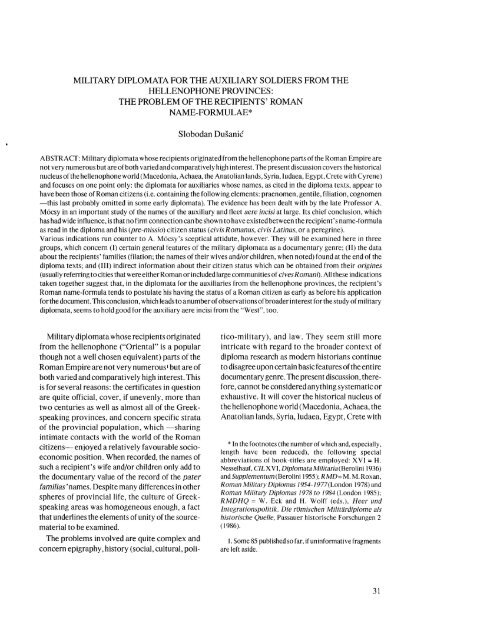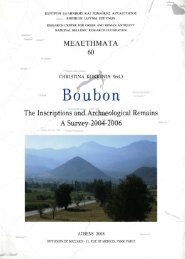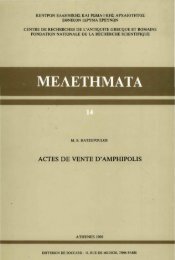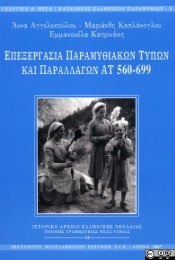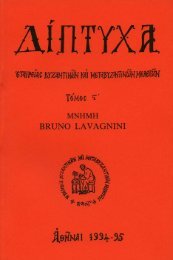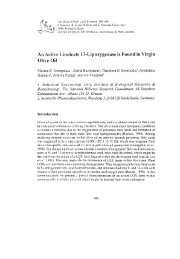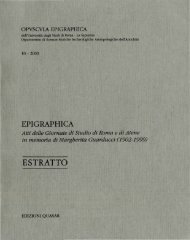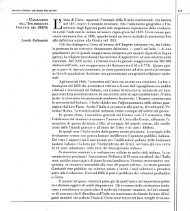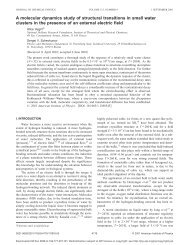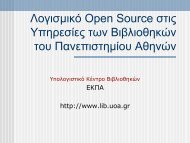roman name-formula
roman name-formula
roman name-formula
- No tags were found...
You also want an ePaper? Increase the reach of your titles
YUMPU automatically turns print PDFs into web optimized ePapers that Google loves.
MILITARY DIPLOMATA FOR THE AUXILIARY SOLDIERS FROM THE<br />
HELLENOPHONE PROVINCES:<br />
THE PROBLEM OF THE RECIPIENTS' ROMAN<br />
NAME-FORMULAE*<br />
Slobodan Dusanic<br />
ABSTRACT: Military diplomata whose recipients originated from the hellenophone parts of the Roman Empire are<br />
not very numerous but are of both varied and comparati vely high interest. The present discussion covers the historical<br />
nucleus of the hellenophone world (Macedonia, Achaea, the Anatolian lands, Syria, Iudaea, Egypt, Crete with Cyrene)<br />
and focuses on one point only: the diplomata for auxiliaries whose <strong>name</strong>s, as cited in the diploma texts, appear to<br />
have been those of Roman citizens (i.e. containing the following elements: praenomen, gentile, filiation, cognomen<br />
—this last probably omitted in some early diplomata). The evidence has been dealt with by the late Professor A.<br />
Mócsy in an important study of the <strong>name</strong>s of the auxiliary and fleet aere incisi at large. Its chief conclusion, which<br />
has had wide influence, is that no firm connection can be shown to have existed between the recipient's <strong>name</strong>-<strong>formula</strong><br />
as read in the diploma and his (pre-missio) citizen status (civis Romanus, civis Latinus, or a peregrine).<br />
Various indications run counter to A. Mócsy's sceptical attidute, however. They will be examined here in three<br />
groups, which concern (I) certain general features of the military diplomata as a documentary genre; (II) the data<br />
about the recipients' families (filation; the <strong>name</strong>s of their wives and/or children, when noted) found at the end of the<br />
diploma texts; and (III) indirect information about their citizen status which can be obtained from their origines<br />
(usually referring to cities that were either Roman or included large communities of cives Romani). All these indications<br />
taken together suggest that, in the diplomata for the auxiliaries from the hellenophone provinces, the recipient's<br />
Roman <strong>name</strong>-<strong>formula</strong> tends to postulate his having the status of a Roman citizen as early as before his application<br />
forthe document. This conclusion, which leads to a number of observations of broader interest for the study of military<br />
diplomata, seems to hold good for the auxiliary aere incisi from the "West", too.<br />
Military diplomata whose recipients originated<br />
from the hellenophone ("Oriental" is a popular<br />
though not a well chosen equivalent) parts of the<br />
Roman Empire are not very numerous 1 but are of<br />
both varied and comparatively high interest. This<br />
is for several reasons: the certificates in question<br />
are quite official, cover, if unevenly, more than<br />
two centuries as well as almost all of the Greekspeaking<br />
provinces, and concern specific strata<br />
of the provincial population, which —sharing<br />
intimate contacts with the world of the Roman<br />
citizens— enjoyed a relatively favourable socioeconomic<br />
position. When recorded, the <strong>name</strong>s of<br />
such a recipient's wife and/or children only add to<br />
the documentary value of the record of the pater<br />
familias '<strong>name</strong>s. Despite many differences in other<br />
spheres of provincial life, the culture of Greekspeaking<br />
areas was homogeneous enough, a fact<br />
that underlines the elements of unity of the sourcematerial<br />
to be examined.<br />
The problems involved are quite complex and<br />
concern epigraphy, history (social, cultural, poli<br />
tico-military), and law. They seem still more<br />
intricate with regard to the broader context of<br />
diploma research as modern historians continue<br />
to disagree upon certain basic features of the entire<br />
documentary genre. The present discussion, therefore,<br />
cannot be considered anything systematic or<br />
exhaustive. It will cover the historical nucleus of<br />
the hellenophone world (Macedonia, Achaea, the<br />
Anatolian lands, Syria, Iudaea, Egypt, Crete with<br />
* In the footnotes (the number of which and, especially,<br />
length have been reduced), the following special<br />
abbreviations of book-titles are employed: XVI = H.<br />
Nesselhauf, C/LXVI, Diplomata M/7/'faria(Berolini 1936)<br />
and5upp/ementum(Berolini 1955); RMD=M. M.Roxan,<br />
Roman Military Diplomas 1954-1977'(London 1978) and<br />
Roman Military Diplomas 1978 to 1984 (London 1985);<br />
RMDHQ = W. Eck and H. Wolff (eds.), Heer und<br />
Integrationspolitik. Die römischen Militärdiplome als<br />
historische Quelle, Passauer historische Forschungen 2<br />
(1986).<br />
1. Some 85 published so far, if uninformative fragments<br />
are left aside.<br />
31
Cyrene) 2 and focus on one point only: the diplomata<br />
for auxiliaries whose <strong>name</strong>s, as cited in the<br />
diploma texts, appearto have been those of Roman<br />
citizens. The legal and social status of (ex-) auxiliaries<br />
was so different from the status of (ex-)<br />
sailors, praetorians and other soldiers whose troop<br />
membership were eligible to diplomata that no<br />
detailed justification of this aspect of our paper<br />
seems necessary. As to the paper's concentration<br />
on the Roman <strong>name</strong>-<strong>formula</strong>e, its principal purpose<br />
is to contribute to recent debates on the legal value<br />
of auxiliary diplomata distributed to men who were<br />
already cives Romanibef ore becoming emeriti of<br />
veterans. This is not, of course, forgetting that an<br />
analysis of military diplomata of the category<br />
selected herein can also prove useful from the point<br />
of view of the students of provincial history or<br />
onomastics in general.<br />
Among the auxiliary aere incisP of "Eastern"<br />
origin, people bearing the Roman citizens' <strong>name</strong><strong>formula</strong>e<br />
(abbr. CNFH are encountered for the first<br />
time in the early years of Domitian's reign. In the<br />
following decades, they become frequent enough.<br />
On present evidence, the latest example that can be<br />
reliably dated is from AD 179 but it is quite probable<br />
that such recipients continued to be registered<br />
till the end of the issue of diplomata for auxiliaries<br />
(which took place at a time, still impossible to fix<br />
precisely, after AD 203) 5 . Naturally, there are also<br />
auxiliary diplomata for "Orientals" with the peregrine<br />
<strong>name</strong>-<strong>formula</strong> (PNF) 6 , in the pre-Domitianic<br />
(the earliest published so far belongs to AD 75) 7 as<br />
well as the post-Domitianic period. They occur in<br />
approximately the same numbers as the diplomata<br />
for the CNF recipients 8 . In "Western" provinces,<br />
including Thrace and Moesia Inferior, the ratio is<br />
much more favourable for the PNF (almost 6: l) 9 ;<br />
the CNF start there as late as AD 102 l0 . That circumstance,<br />
which has been foundhistorically significant,<br />
justifies by itself a close analysis of the "Oriental"<br />
CNF cases. They can be summarized as follows 11 :<br />
XVI 28 (AD 82)»2 L. Valerio L. f. Pudenti,<br />
Ancyr(a); ex ped. cohort. I Aquitanorum (Germ./<br />
Moes.); near Novae (Moes., future Moes. Inf.).<br />
XVI29 (AD 83) C. Iulio C. f. Saturnino, Chio<br />
centurioni cohort. I Hispanorum (Aeg.); Coptus<br />
(Egypt).<br />
32<br />
S. DUSANIC<br />
XVI 39 (AD 93) L. Cassio Cassi f., Larisen(si);<br />
pediti cohort. I Cisipadensium (Moes. Sup.); near<br />
Bononia (Moes. Sup.).<br />
2. Of these provinces, Iudaea and Crete-Cyrene have as<br />
yet produced no CNF auxiliary with a (published) diploma;<br />
Anatolia is represented through Asia and Galatia only.<br />
Moesia Inferior andThrace have been excluded (they have<br />
supplied no CNF auxiliary in the diplomata edited so far)<br />
as deep differences divided the Thracians from the rest of<br />
the Hellenophone world. On the other hand, senatorial<br />
provinces are included. The auxiliary regiments enlisted a<br />
number (though probably small, in the early period) of soldiers<br />
there; despite the contention of Th. Mommsen and some<br />
others that such a practice would have been illegal. Cf. the<br />
case of tirones Asiani (AD 117; R. O. Fink, Roman Military<br />
Records on Papyrus, APhAss. Monographs 26 [ 1971 ] 277ff.<br />
no. 74) referred to by A. Mócsy in RMDHQ450.<br />
3. For the term, which connotes something of the honour<br />
felt by the recipients of diplomata, see RMDHQ193 note<br />
14 (S. Dusanic).<br />
4. Which occur, in the cases examined below, in five<br />
variants (listed in the chronological order of appearance<br />
in our documents): (a) praenomen, gentile, filiation by<br />
praenomen, cognomen; (b) praenomen, gentile, filiation<br />
by gentile; (c) praenomen, gentile, filiation by cognomen;<br />
(d) praenomen, gentile, filiation by cognomen, cognomen;<br />
and (e) praenomen, gentile, filiation by gentile, cognomen.<br />
5. RMDHQ556ff., especially 566 (W. Eck and H. Wolff).<br />
6. In diplomata, it always consists of the <strong>name</strong> and the<br />
patronymic.<br />
7. RMD2, see infra.<br />
8. RMDHQA51 (A. Mócsy). Fresh finds change Mócsy's<br />
figures only slightly.<br />
9. Ibid.<br />
10. XVI47. After 102, some 15 diplomata for auxiliaries<br />
having a "Western" or Thracian origo and bearing the CNF<br />
have been registered (see M. M. Roxan's Table III in<br />
RMDHQ 282f.); as the "West" (together with the two<br />
Thracian provinces) provides the great majority of<br />
diplomata known so far, that high total is not surprising.<br />
11. The catalogue items give the following data: the basic<br />
publication of the diplomaandthe year of the document's<br />
issue; the recipient's <strong>name</strong> and origo (ethnic); his rank,<br />
unit, and the unit's province; the <strong>name</strong>(s) of his wife and/or<br />
children (when noted); andthe find-spot (with the indication<br />
of its province) of the diploma, precise or approximate. In<br />
the sequel, the items will be usually referred to by the year<br />
of the diploma. The catalogue does not list men whose<br />
origines are not extant in the diplomata, or are given as<br />
castris. All such cases are excluded as uncertain, though<br />
various facts may indicate that some of these recipients<br />
were "Orientals" (e.g. XVI128; App. 2).<br />
12. On the date of the diploma and its "two-province"<br />
unit list, RMDHQ205-201 (Dusanic).
XVI42 (AD 98) P. Insteio Agrippae f., Cyrrh(o)<br />
ex pedite cohort. I August. Ituraeorum (Pann.);<br />
the territory of the Hercuniates (Pann., future<br />
Pann. Inf.).<br />
XVI 44 (AD 99) M. Antonio M. f. Rufo,<br />
Abretten(o); pediti cohort. II Gallorum (Moes. Inf.);<br />
et Marco f. eius not far from Tomi (Moes. Inf.).<br />
ZPE70(1987) 189-194'KAD 109)M.Herennio<br />
M. f. Polymitae(!) 14 , Berens(i)(!); ex pedite coh. I<br />
Montanor. (Dae); et Ianuario et Marcello f. eius<br />
et Lucanaefil. eius; near Viminacium (Moes. Sup.).<br />
RMD 14 + p.128 n.20 (ADI 14) C. Iulio C. f.<br />
Valenti, Trall[i ?]is; ex equite coh. IUI Gallor.<br />
(Thr.); et Iulio f. eius et Valentinae fil. ei[us] et<br />
Gaiae fil. eius; Pisarevo in Thrace.<br />
XVI 67 (AD 120) M. Antonio Timi f. Timi'6,<br />
Hierapol(i); ex pedite coh. I Flav. Bessor. (Mac);<br />
et Doroturmae Dotochae fil. uxori eius, Tricorn-<br />
(ensi), et Secundo f. eius et Marcellinae fil. eius;<br />
Tricornium (Moes. Sup.).<br />
XVI 169 (AD 122) M. Antonio Antoni f.<br />
Maximo, Syro; ex gregale alae Gallor. Taurian. c.<br />
R. torquat. victr. (Maur. Ting.); et Valeriae Messi<br />
fil. Messiae uxori eius, Transduc(ta), et Maximo<br />
f. eius et Maximae fil. eius; Valentia Banasa (Maur.<br />
Ting.).<br />
XVI 78 (AD 134) L. Sextilio Sextili f. Pudenti,<br />
Stobis; ex pedite coh. I Claudiae Sugambr. (Moes.<br />
Inf.); et Lucio f. eius et Valerio f. eius et Petronio<br />
f. eius et Valenti f. eius et Luciae fil. eius et Anniae<br />
fil. eius; in Barbarico (to the North of the Lower<br />
Moesian Danube, in the future Dacia).<br />
Ai A 95 (1991) 469-488 (AD 138) [- - - ] e f.<br />
Galbae, Cyrrho; [ex] pedite coh. I Musulamiorum<br />
(Lye. et Pamph.) [et — ] pitis fil. uxori (eius)<br />
Pamph[ylae et [— ] f. eiu]s et Valenti f. eius;<br />
Laertes (Pamph.).<br />
XVI 131 + RMD p. 126 and 134 (AD 178/190)<br />
[- - - c. 12 letters - - - ]i f. Sigillio, [- - - c.7 letters -<br />
- - ] aex Syr(ia) [ex p]edite [cohort. I Hem]esenor.<br />
(Pann. Inf.); Lower Pannonia?<br />
RMD 123 (AD 179) Ulpio Ulpi f. Herculano,<br />
Stobis; ex ped. cohor. III Campestr. (Dae. Sup.);<br />
Drobeta (Dacia).<br />
MILITARY DIPLOMATA: NAME-FORMULAE<br />
The major part of the evidence presented in the<br />
foregoing catalogue has been dealt with by the late<br />
Professor A. Mócsy in an important study of the<br />
<strong>name</strong>s of the aere incisi at large —primarily those<br />
of the auxiliaries and the classiarii. Its chief conclusion,<br />
which has had wide influence, is that no<br />
firm connection can be shown to have existed<br />
between the recipient's <strong>name</strong> <strong>formula</strong> as read in<br />
the diploma and his (pre-missio) citizen status<br />
(civis Romanus, civis Latinus", or a peregrine).<br />
Applying this negative conclusion to the CNF<br />
recipients from the auxilia, Mócsy suggested that<br />
in two cases only the CNF —which, in the diplomata<br />
for auxiliaries, never includes the tribus— would<br />
be very likely to reveal people who had become<br />
13. Cf. J. Garbsch, BVW54(1989) 137-151.<br />
14. Polymitae (a hapax) from Πολυμήτης rather than<br />
Πολυμίτας or Πολυμήδης.<br />
15. Trall[i] RMD, Trall(ibus) RMDHQA1\ (M. P.<br />
Speidel). Both the readings are possible (the former being<br />
more probable if the bronze shows that a letter was lost<br />
after TRALL) and point to the same Anatolian town,<br />
Tralle(i)s, not totheThracian tribe Tralleis; even a Trall(iano)<br />
or Trall[i](ano) cannot be ruled out. On various forms of<br />
the toponym and the ethnic see W. Ruge, RE VI A( 1937)<br />
col. 2 lOOf, s.v. Tralleis (no. 2); they include the nominative<br />
Trallis (-is), which could produce the ablative Trall[i].<br />
16. The cognomen and patronymic are obviously the<br />
same <strong>name</strong>, in twoheteroclitic variants: Τίμι(ο)ς, latinized<br />
as Timis, -is (the cognomen) and Timius, -i (the patronymic)<br />
at the same time.<br />
17. Th. Mommsen (Ges. Sehr. VI 43ff. 76ff.) advanced<br />
the hypothesis that those of the CNF auxiliaries whose<br />
<strong>name</strong>s include an ethnic (instead of a city -origo) but exclude<br />
a tribe-indication were of a Latin status. That hypothesis<br />
has proved untenable, and with good reason Mócsy did not<br />
consider it, having reduced our choice as to the legal<br />
identification of the CNF bearers to two possibilities: Roman<br />
citizens or peregrines (crypto-peregrines, as called infra).<br />
Cf. H. Wolff, Chiron 6 (1976) 267-288; P. A. Holder, The<br />
Auxilia from Augustus to Trajan, BAR Int. ser. 70 (Oxford<br />
1980) 50ff.; D. B. Saddington, The Development of the<br />
Roman Auxiliary Forces from Caesar to Vespasian, 49<br />
B.C-A.D. 79 (University of Zimbabwe 1982) 192,250and<br />
261. On the problem of the omission of the rribusfrom the<br />
CNF of the auxiliary aere incisi, below, note 24.<br />
33
Roman citizens before their discharge and/or<br />
receiving the diplomata: when the recipient's<br />
praenomen differs from his father's (no example<br />
known as yet among the "Eastern" bearers of the<br />
CNF), and when the recipient's rank was high<br />
enough (e.g. centuno cohortis, AD 83) to imply<br />
the possibility of a translatusex legione. All other<br />
CNF of the "Oriental" auxiliaries' bronzes were<br />
invented, in Mócsy's opinion, by the provincial<br />
officials at the moment of the future soldier's<br />
probatio. In order to give the tiro a <strong>name</strong> conforming<br />
to Roman taste and usage, those clerks<br />
replaced the tiro 's original <strong>name</strong>s —even if he<br />
bore a PNF— by a CNF; Mócsy was inclined to<br />
believe that the recruit's Greek or "barbarian"<br />
cognomen (or principal <strong>name</strong>, if the man was a<br />
peregrine) also had to be changed on that occasion.<br />
According to the Hungarian scholar's reasoning,<br />
the majority of the soldiers whose <strong>name</strong>s are<br />
enumerated supra may have been peregrines till<br />
the day of becoming aere incisi^. Mócsy probably<br />
reckoned very much on that possibility (which<br />
depends on his theory that the tria nomina need<br />
never presuppose their bearers' status of cives<br />
Romani) as purely Roman cognomina prevail in<br />
our catalogue.<br />
Various considerations run counter to Mócsy's<br />
hypothesis, however. They may be envisaged in<br />
three groups, which concern (I) general indications<br />
that, in the diplomata at least, the CNF tended to<br />
denote cives Romani; (II) the data about the<br />
recipients' family (filiation; the <strong>name</strong>s of their<br />
wives and/or children, when noted) found at the<br />
end of the diploma texts; and (III), indirect information<br />
about their citizen status that can be obtained<br />
from their origines. While partly aware of the<br />
difficulties presented to his theory by (I) and (II),<br />
Mócsy did not discuss (III).<br />
(I)<br />
There can be little doubt that Roman citizens<br />
did appear —and increasingly, with time— in the<br />
circle of the candidates for the auxiliary diplomata.<br />
That tendency led i. a. to the introduction c. AD<br />
140 of the qui eorum non haberent in the clause<br />
(Imperator ...equitibus et peditibus...) civitatem<br />
Romanam... dedit. Some features of the epikrisis<br />
documents seem to point in the same direction<br />
34<br />
S.DUSANIC<br />
and imply that citizenship was acquiredby certain<br />
aere incisi from auxilia "during (or at the end of)<br />
their military service" but before their candidature<br />
to diplomata 19 . Admittedly, a natural inference<br />
from such a state of affairs is that the CNF appertained<br />
to that class of recipients whose citizen<br />
status (either inherited or acquired during service)<br />
and frequency made the authors of the constitutiones<br />
underlying the diplomata introduce the qui<br />
eorum non haberent modifier 20 .<br />
This inference gains probability with regard to<br />
two facts: in pre-Domitianic times, the CNF is absent<br />
from the "personal" part of the texts of diplomata<br />
for auxiliaries, which cites the PNF only; the<br />
simultaneous use of both onomastic <strong>formula</strong>e<br />
continues from Domitian's reign into the late<br />
Antonine epoch, and probably beyond it. If the<br />
use of the CNF had been officially permitted to<br />
those aere incisi who did not possess Roman<br />
citizenship before obtaining their bronzes, we<br />
should expect the PNF to occur there rarely or<br />
never, especially in the post-140 period. The effect<br />
of the actual evidence being quite different, it is<br />
hard to accept Mócsy's contention that the CNF's<br />
value, in diplomata, was cultural rather than legal.<br />
The civitas Romana gradually spread to the provinces;<br />
this was due to immigration from Rome<br />
and Italy (and the propagation of the immigrants'<br />
descendants, clients, freedmen), as well as to the<br />
generosity of the Emperors, the provincial governors<br />
and other notables. The notion that cives<br />
Romani could and should serve in auxiliary units<br />
18. RMDHQ431tt\, especially 4501. 4561. 461-3. Cf.<br />
Mócsy, Klio52 ( 1970) 287ff. Similar ideas were expressed<br />
by Mommsen (the preceding note), Kraft (who believed<br />
L. Cassius, AD 93, and P. Insteius, AD 98, were peregrines<br />
—because of their <strong>name</strong>-<strong>formula</strong>e) andsome other scholars.<br />
See the critical observations of Holder and Saddington cited<br />
in the preceding note.<br />
19. RMDHQ222 (Dusanic).<br />
20. Cf. XVI 38 (AD 93), with a similar modifier (qui<br />
peregrinae conditionis probati erant) regarding the aere<br />
incisi from the coh. VIII voluntariorum civium Romanorum<br />
(Dalmatia).
was gradually recognized, too 21 . The tempo of<br />
those interrelated processes as we follow them<br />
nowadays corresponds, in the main, with the<br />
changing ratio PNF : CNF in the catalogue of the<br />
recipients of auxiliary diplomata. However, from<br />
that point of view, the fates of the "Eastern" and<br />
"Western" subjects of the Empire were dissimilar,<br />
a fact which will be dealt with at the end of the<br />
present paper.<br />
Our statistical sample is far too small for a more<br />
precise analysis of the chronological order, but<br />
purely epigraphico-onomastic indications tend to<br />
support the thesis that in documents such as<br />
Domitianic and post-Domitianic auxiliary diplomata,<br />
the CNF implies, recipients who were, in<br />
principle, Roman citizens. On the one hand, all<br />
the persons with an obligatory citizens status who<br />
are <strong>name</strong>d in military diplomata of various kinds<br />
—emperors, governors of provinces, the equestrian<br />
army officers, testes 22 , recipients from the<br />
City troops— are consistently given the CNF by<br />
the officials composing the lists of diplomata<br />
beneficiaries.<br />
Demonstrable examples of the use of the PNF<br />
for citizen recipients from the auxilia of fleets are<br />
also missing. Gaius Luci f. (XVI87, AD 139) should<br />
by no means be taken as one since Roman praenomina<br />
are frequently met with in the function of<br />
the peregrines' <strong>name</strong>s —in diplomata 23 and ordinary<br />
inscriptions alike. On the other hand, the<br />
diplomata reveal an analogous bureaucratic<br />
strictness in treating the PNF and omitting the<br />
tribe from the auxiliary CNF 24 . It is instructive to<br />
signal the cases wherein the recipients had some<br />
title to the more imposing style, the CNF, but<br />
remained nevertheless listed with the PNF. The<br />
diplomata for the members of leg. IAdiutrix (AD<br />
68) and II Adiutrix (AD 70) 25 are especially eloquent<br />
in that respect. All their recipients have the<br />
PNF though these soldiers, as (ex-)legionaries,<br />
were in a position to require the CNF from Galba's<br />
and Vespasian's clerks, respectively. It is obvious<br />
that the officium in charge qualified them, essentially,<br />
as sailors, which they really were for the best<br />
part of their military careers. In their capacity as<br />
sailors, they were both entitled to diplomata and<br />
expected to bear the PNF, not CNF, in their certificates.<br />
MILITARY DIPLOMATA: NAME-FORMULAE<br />
The nomenclature of many recipients reflects,<br />
therefore, a clerical concern about formalities<br />
typical of diplomata —as highly official types of<br />
documents— in general. The procedure leading<br />
to the grant of indi vidual diplomata was obviously<br />
complicated and diachronically combined several<br />
sources of information on the beneficiaries; carefully<br />
led, it obviously presupposed the possibility,<br />
even necessity, of more than one consultation of<br />
provincial witnesses who were to provide data on<br />
the recipient and, when needed, his family members<br />
26 . This fact, among others, does not suit<br />
21. Saddington (supra, note 17) 187-192. Cf. intra, note<br />
24.<br />
22. For the exceptional t. 4 of XVI 16 see Epigraphica<br />
46(1984) 103f.<br />
23. M(arcus) Damae f. (XVI 15, AD 71), Perasi (dat.)<br />
Publi f. (XVI22, AD 78),Tertius Marci f. (XVI23, AD 78),<br />
Lucius Terti f. (RMD 108, AD 126/161?), Volsingus Gait.<br />
(RMD55,AD161).<br />
24. The tribes are consistently omitted from the CNF of<br />
diploma recipients for non-citizen troops (auxiliaries,<br />
sailors, Equités Singulares), even in cases wherein such<br />
recipients must be expected to have been cives Romani at<br />
the moment of the issue of the corresponding leges (XVI<br />
160, 163; the most diplomata postdating the Constitutio<br />
Antoniniana, etc.). As is well known, on the contrary,<br />
diplomata for the Praetorians and the Urbaniciani<br />
consistently cite the tribes within the CNF till the later 230's,<br />
and some inscriptions have been found with the tribeindications<br />
added to the <strong>name</strong>-<strong>formula</strong>e of the auxiliary<br />
soldiers (Mommsen, Ges. Sehr. VI 44 note 1 ). In our opinion,<br />
the reason for such a state of affairs should be sought in a<br />
certain legal traditionalism of the clerks responsible for the<br />
production of auxiliary diplomata. Obviously, they did not<br />
findit in orderto include the rribuswithin the <strong>name</strong>-<strong>formula</strong>e<br />
of people receiving documents primarily (and originally)<br />
intended for peregrines. In a similar way, they did not<br />
acknowledge changes in the citizen status of recipients of<br />
naval diplomata on a related point: even in the post-212<br />
diplomata for sailors of the Classes Praetoriae (some of<br />
whom were Italici!), we find neither the qui eorum non<br />
ftaberenrmodifier nor an equivalent to it. Forthe view (not<br />
an uncontroversial one) that the omission of the qui eorum<br />
non haberent from the naval diplomata reflects the scribes'<br />
"legal traditionalism" just spoken of, see RMDHQ222,<br />
TIA (Dusanic).<br />
25. AD 68: XVI 7-9 (cf. AEp. 1985, 770). AD 70: XVI<br />
lOf.<br />
26. RMDHQ233-6 (Dusanic) and 440 (Mócsy). Cf. e.g.<br />
Pliny, Ep. X 29f.<br />
35
Mócsy's hypothesis that the diplomata consistently<br />
repeat the <strong>name</strong>-<strong>formula</strong>e under which the recipients<br />
were originally entered in the lists of recruits<br />
preservedin the officiaoïthe provinces' governors.<br />
It is still less compatible with the corollary of the<br />
same hypothesis which makes the lists subject to<br />
their compilers ' arbitrary choice between the PNF<br />
and the CNF, and ascribes the clerks a tendency<br />
not only to give the CNF to the peregrine tirones<br />
but also to change the tirones' native <strong>name</strong>s<br />
(cognomina) into "einfache lateinische Namen...<br />
die aus einer beschränkten Zahl von 'Soldaten<strong>name</strong>n'<br />
gewählt wurden" 27 .<br />
The Syrian examples —pertaining to a major<br />
province, which has left us a comparatively<br />
important amount of documentation— suffice to<br />
show some defects of the theory that provincial<br />
recruiting-officers had their own standards as to<br />
the selection of the recruits' <strong>name</strong>-<strong>formula</strong>e,<br />
standards allegedly determining the way in which<br />
the "personal" part of the auxiliary diploma text<br />
was going to be <strong>formula</strong>ted more than two and a<br />
half decades after the probatio. Our catalogue cites<br />
five men from that province, who were granted<br />
their diplomata in AD 98, 120, 122, 138, and<br />
178/190 respectively. Their CNF has been expressed<br />
through at least three variants (c, d, e, possibly<br />
also a) 28 . Besides, Syria has produced a PNF<br />
recipient (RMD2, of AD 75 : Herae Serapionis f.,<br />
Antioc), who must have been a peregrine to judge<br />
(i.a.) from the early date of the document. To that<br />
plurality of <strong>name</strong>-<strong>formula</strong>e belonging to auxiliaries<br />
whose origins were in the same province, another<br />
detail can be added which also contradicts Mócsy 's<br />
ingenious conjectures: both the patronymic and<br />
the <strong>name</strong> (cognomen) of the Antiochene of RMD<br />
2 are non-Roman —nothing similar to the simple<br />
"Soldaten<strong>name</strong>n",— and the same holds true for<br />
the soldier rewarded in AD 120. Finally, the origines<br />
as quoted supra show a variety of form and content<br />
which by itself contrasts with the practice of distinct<br />
provincial patterns assumed by Mócsy. Thus we<br />
see the dative Syro in AD 122, the toponyms in<br />
the ablatives in AD 98,120 (probably) 29 , and 138,<br />
and the composite <strong>formula</strong> [— ] a ex Syr(ia) in<br />
178/190. Diplomata whose recipients did not<br />
belong to the group of auxiliaries with the CNF<br />
make this repertory somewhat more complete:<br />
36<br />
S. DUSANIC<br />
Suros ( ! ) (XVI8, AD 68), Suro Garaseno ( ! ) (XVI<br />
15, AD 71), and Antiochia ex Syria Coele (ZPE<br />
96 [ 1993] 77; AD 206). All these variations of the<br />
<strong>formula</strong>e noting the recipients' home —their<br />
orthography as well as their structure— can also<br />
be followed in diplomata distributed to men from<br />
other provinces, even Italy itself. They illustrate<br />
changes and oscillations in the scribal conventions<br />
in central officia, not the decisive influence of lists<br />
composed locally, in Syria or elsewhere.<br />
(ID<br />
Our short catalogue gives us an insight into the<br />
family situations of the auxiliary aere incisi born<br />
in "Oriental" provinces. There are reasons to believe<br />
that the most of them were families of Roman<br />
citizens.<br />
To begin with, in at least four diplomata (of AD<br />
93, 122,134, and 179), the recipient's filiation is<br />
that by (his father's) gentile. The case of M. Antonius<br />
Maximus' wife is probably the same (AD<br />
122) 30 . Though the purpose of the <strong>formula</strong>—which<br />
is not rare in inscriptions and other diplomata—<br />
has been a matter of learned controversy, it is<br />
difficult to escape from the conclusion that "it was<br />
to give sure proof of Roman citizenship" as "the<br />
normal method (i.e. the filiation by praenomen)<br />
could be usurped by peregrines" 3 '. Neither<br />
27. RMDHQ462 (Mócsy).<br />
28. (C): AD 98; (d): AD 120; (e): AD 122; (d) or, less<br />
probably, (e): AD 138 (the [—]e f. ended a cognomen —<br />
e.g. [Galba]ef.—ratherthan agentile—e.g. [Caecina]ef.;<br />
(e), (d) or, less probably, (a): AD 178/190 (the [- - -]i f. should<br />
de restored as a gentile or a cognomen rather than a<br />
praenomen).<br />
29. The alternative HeliopoI(itano)stems less plausible,<br />
cf. Nicopoli (RMD 132), Claudiopoli(RMD 133).<br />
30. It seems that her gentile was Messia, not Valeria<br />
(which should be taken for the gentile in the function of the<br />
cognomen). The position of the two <strong>name</strong>s has been changed<br />
by an inversion well known from epigraphical documents.<br />
31. Holder (supra, note 17) 51. Aliter, F. Papazoglou<br />
(infra, note 61 ) 317 note 55 (on the Ulpius Ulpi f. of RMD<br />
123).
does the omission of the recipient's cognomen in<br />
the example of AD 93 imply a (crypto-) peregrine 32 .<br />
The diploma was issued at a time when the cognomina<br />
were not as yet obligatory to record 33 ; among<br />
the testes (who as such were all citizens) to XVI3<br />
(AD 54), there is a man with an analogous <strong>name</strong><strong>formula</strong><br />
34 . And the percentage of <strong>formula</strong>e containing<br />
the kinds of filiation which were not by the<br />
father's praenomen (the latter being "die homonyme<br />
Filiation" in Mócsy 's terminology) is high<br />
enough (AD 93,98,120,122,134,138,178/190?,<br />
179) to discourage the notion that the "homonyme<br />
Filiation" was preferred by the constructions of<br />
the fictitious CNF. After all, C. Iulius C. f. Saturninus'<br />
rank of the centuno cohorts (AD 83) makes<br />
it probable that his citizenship went back to his<br />
father at least 35 .<br />
Second, the nomenclature of children. As in<br />
many other texts, in our diplomata it tends to derive<br />
from the praenomina, gentilicia, or cognomina of<br />
the fathers (AD 99, 109 [Marcellus] 114, 120<br />
[Marcellino], 122, 134 [Lucius, Lucia]). If the<br />
fathers ' <strong>name</strong>s were more or less arbitrarily selected,<br />
it would have been strange to find them in such<br />
numbers as the source of the children's cognomina.<br />
The relative colourlessness of all these <strong>name</strong>s does<br />
not suffice, by itself, to prove the hypothesis of<br />
their administrative, not family, origin. This will<br />
have been especially true in the case of the cognomina,<br />
the choice of which must have been upon<br />
the soldiers themselves. For, generally speaking,<br />
the aere incisi wert mot forbidden from preserving<br />
non-Roman cognomina for themselves (AD 109,<br />
122, and many diplomata not in our list) or giving<br />
them to their sons and daughters 36 . No bureaucratic<br />
considerations of expedience seem to have been<br />
at work there; let us note, after all, that the children's<br />
Roman cognomina need not have meant an advantage<br />
for their bearers when the recipient's decision<br />
was to live in ahellenophone area after his honesta<br />
missio (AD 98, 114, 138)37. Thence the nomenclature<br />
of the children and its source in the fathers '<br />
<strong>name</strong>s can lend no support, to say the least, to<br />
Mócsy 's theory of artificial <strong>name</strong>-giving in the<br />
officia of the probatores.<br />
Third, the diploma of AD 98, issued P. Insteio<br />
Agrippae f., Cyrrh(o). As pointed out by B. Isaac38,<br />
the father of the recipient was likely to owe his<br />
MILITARY DIPLOMATA: NAME-FORMULAE<br />
(rare enough) gentile and his citizen status to<br />
Insteius Capito, Domitius Corbulo's praefectus<br />
castrorum in Armenia (AD 58) 39 . The cognomen<br />
Agrippa points to Herod Agrippa or, rather,<br />
Agrippa II. "The following curriculum vitae of<br />
father and son is suggested: Agrippa, the father,<br />
will have served in an Ituraean unit of Agrippa II<br />
—hence the <strong>name</strong>— which was dispatched to<br />
reinforce Corbulo's army in Armenia. He served<br />
under the command of Insteius Capito, whose<br />
gentile <strong>name</strong> he gave to his son. He may have been<br />
based at Cyrrhus, where the son was born. The son<br />
joined the Roman army when the Ituraean forces<br />
had already been organized as regular auxiliary<br />
units" 40 . There may be analogous items in our list<br />
for which various indications —onomastic, historico-military,<br />
geographical— tend to reveal that<br />
the recipient's ancestors (and, very probably, the<br />
32. The same holds true for the example of AD 98.<br />
33. Holder (supra, note 17) 51 and 53, against Kraft.<br />
34. Ti. Sex. Magius, b(eneficiarius) Rufi navarchi (cf.<br />
Nesselhauf's index of the Signatorum nomina, p. 200; the<br />
same <strong>name</strong> is entered in the index of RMD p. 104 in two<br />
variants [Sex. Magius Rufus, Sex. Magius], as it figures in<br />
the diploma in the [usual] genitive: Sex. Magi...).<br />
35. Mócsy (in RMDHQ451 with note 55) thought of the<br />
centuno as a translatus ex legione.<br />
36. To quote only some examples of children of the CNF<br />
auxiliaries: RMD 11 ; 86; 20; 32 (all coming from the "West").<br />
37. In such areas, Greeks <strong>name</strong>s will have been socially<br />
preferable (cf. e.g. E.A. Meyer, JRSS0 [1990] 91-4). No<br />
doubt, the fathers receiving the diplomata of AD 98, 114,<br />
and 138 had sufficient reasons not to choose them for their<br />
children, reasons which are best connected with the fathers'<br />
family traditions and army lives. As to the <strong>name</strong>-giving<br />
illustrating these latter (cf. e.g. Emeritus and Emerita in<br />
XVI2, Caucus and Putiolanusin RMD 133), note that the<br />
<strong>name</strong> Lucana (AD 109) probably reflects the contacts which<br />
the father's unit had with the soldiers from Lucus Augusti<br />
(cf. XVI47, with note 8).<br />
38. RMDHQ259-261.<br />
39.P/K2I31.<br />
40. Holder (supra, note 17) 53 (cf. RMDHQ454 note<br />
61, Mócsy) wrote: "Insteius, in fact, may well have been<br />
descended from someone enfranchised by M. Insteius, a<br />
supporter of Antony (PIR 2 128)". But the citizenship of<br />
the recipient of XVI42 probably went back to a Publius.<br />
37
ecipient himself, too) really possessed civitas<br />
Romana; RMD 123 (AD 179), issued Ulpio Ulpi<br />
f. Herculano, Stobis, seems to be one 41 . It was<br />
essentially the same practice which led to the<br />
formation of (at least) three auxiliary cohorts<br />
civium Romanorum in the "East" during the<br />
Flavio-Trajanic period 42 .<br />
(Ill)<br />
It is a neglected fact that the homes of men whose<br />
<strong>name</strong>s are dealt with in the foregoing pages were<br />
in cities that were either Roman (AD 134, 170:<br />
Stobi, municipium iuris Italici) or included large<br />
communities of civesRomani. The only exception<br />
to that is the Abretten(o) of AD 99, pertaining to<br />
a koinon in northern Asia (Mysia) 43 . The majority<br />
or quasi-totality of these data cannot be assigned<br />
to the category, doubtful in itself when it comes<br />
to documents as official as diplomata, of the "new"<br />
origines 44 .<br />
To prove the point on the crucial rôle of Greek<br />
cities with important communities of Roman<br />
citizens, we have to begin with a discussion —brief<br />
and, as far as possible, free of the circular argument—<br />
of origines whose identification is open<br />
to controversy. Four such cases have been recorded:<br />
Ancyr(a) in AD 82, Larisen(si) in AD 93,<br />
Berens(i) (!) in AD 109, and Hierapol(i) in AD<br />
120. All other items in the catalogue refer either<br />
to the clear Syro/ex Syr(ia) (AD 122,178/190) or<br />
contain toponyms whose identity is virtually<br />
beyond doubt (AD 83, 98, 114, 134, 138, 179) 4 \<br />
Of the two Ancyrae which shouldbe theoretically<br />
considered in an attempt to determine the patria<br />
of the recipient of XVI28, the Galatian is a much<br />
better candidate, being far greaterthan its Phrygian<br />
homonym, and likely to enlist an auxiliary in the<br />
season of Nero's Parthian War 46 . So far as we can<br />
see, no student of diplomata has thought otherwise.<br />
P. A. Holder writes on the recipient of XVI39:<br />
"There are a number of towns called Larissa 47 and<br />
it has been suggested he came from the one in<br />
Thessaly. However, as he was a citizen, his home<br />
town is more likely to have been in an area where<br />
recruits served in the legions or auxilia. No recruits<br />
are known from Thessaly at this time, therefore<br />
Asia Minor is amore suitable province of origin" 48 .<br />
This comment is not convincing, and it has not<br />
38<br />
S. DUSANIC<br />
been followed. On the one hand, there was no<br />
visible reason, in the last years of Nero's reign, to<br />
search as far as Anatolia (or Syria) for a pedes of<br />
an Illyrican auxiliary cohort. On the other, Thessaly<br />
did supply auxiliaries in the early period 49 . We<br />
prefer therefore to identify L. Cassius ' home with<br />
the famous Larisa on the Peneus.<br />
41. His grandfather was presumably a soldier of the coh.<br />
I Hispanorum veterana stationed at Stobi under Trajan"<br />
(Fink [supra, note 2] 217-227, no. 63; cf. F. Papazoglou, in<br />
ANRWU 7. 1 [Berlin-New York 1979] 349f.). Missus<br />
honestamissioneandgiven the citizenship by that Emperor,<br />
the grandfather may have returned to settle in Stobi. The<br />
Ulpiiare otherwise not attested there (F. Papazoglou, Chiron<br />
16 [1986] 234).<br />
42. Holder (supra, note 17) 67f.<br />
43. Not to the fort of Abrit(t)us in Moesia Inferior, as<br />
assumed by some. Its ethnic had a different form, see ILS<br />
2670, castell. Abritanor(um).<br />
44. Forthat notion, RMDHQ418Ï. (Speidel). Note that<br />
the find-spots of our diplomata never coincide with the<br />
areas to which the origines point.<br />
45. It is evident that the Cyrrhus of AD 98 and 138 must<br />
be the Syrian, not the Macedonian, town. The Thracian<br />
alternative should be excluded, without hesitation, in the<br />
case of the origo of AD 114.<br />
46. RMDHQ206Ï. note 74 (Dusanic).<br />
47.Somel5areregisteredintheKEXII(1924)col.840-<br />
873 (cf. Diz. ep. IV 410-19). Of them, five may be envisaged<br />
here: Larisa-on-the Peneus (RE, loc. cit., no. 3), Larisa<br />
Cremaste (no. 2), Larisa on Ossa (no. 4), Larisa in the plain<br />
of theCayster(no. 9; Holder would have thought of it rather<br />
than Larisa Phryconis, no. 8, or Larisa near Tralles), and<br />
Larisa Syriae (no. 12). The importance of the first-mentioned<br />
(in the Roman epoch particularly) far surpassed the<br />
importance of the rest; moreover, the considerations of<br />
military history and geography, briefly dealt with in the<br />
sequel, give Larisa-on-the-Peneus a clear advantage over<br />
its homonyms in Greece and Asia Minor. As to the form<br />
of the ethnic, we prefer, with a number of scholars, the<br />
Larisen(si) (cf. e.g. the ethnic Amphissenses and the like)<br />
to the Larisen(o) printed in CIL III and XVI.<br />
48. Holder (supra, note 17) 125 note 15.<br />
49. Saddington (supra, note 17) 162.
Lesser homonyms or near-homonyms excluded<br />
50 , the Berens(i) (AD 109) —best read Ber<br />
ens(i^— leaves us with three theoretical possibilities<br />
of identification of the town in question:<br />
Beroea Macedoniae, Beroea Syriae, and Beroe(a),<br />
alias AugustaTraiana, in Thrace. This last may be<br />
dismissed as its history was such that in the pre-<br />
Trajanic period (Herennius and his contirones<br />
were enlisted c. AD 84) it could not have housed<br />
many Roman citizens —and least those with the<br />
non-imperial gentilicia 52 . Between the Macedonian<br />
and the Syrian town, the choice must fall on the<br />
former. It lay within the recruiting area of the<br />
Danubian army 53 , to which the coh. I Montanorum<br />
of the diploma's recipient belonged. The case of<br />
Beroaea Syriae (like the two overseas Laris(s)ae)<br />
was different —at least in normal situations, and<br />
the years about AD 84 must have been normal<br />
from that point of view as coh. I Montanorum and<br />
the Danubian troops in general had no business at<br />
that time to be in the East or to recruit the Syrians.<br />
Lastly, the considerations from the disposition<br />
of legions and auxilia in the season of Trajan's<br />
Parthian War make it probable that the Hierapol(i)<br />
of AD 120 means the town in Cyrrhestice, not one<br />
of the Hierapolises in Asia Minor (there were three<br />
Anatolian cities ofthat <strong>name</strong>) 54 . Between its stay<br />
in Moesia Superior at the very beginning of the<br />
second century (XVI 46) and its transfer to<br />
Macedonia in the early years of Hadrian's reign<br />
(XVI67), the coh. I Flavia Bessorum must have<br />
been part of the Upper Moesian expeditionary<br />
corps sent to fight the Parthians c. AD 114. In the<br />
East —Cyrrhestice precisely— it was likely to<br />
receive some Syrians from the local regiments, to<br />
compensate losses in the war 55 . The elderly M.<br />
Antonius of XVI67 will have been transferred to<br />
IFlavia Bessorum on that occasion; no Anatolian<br />
Hierapolis had an occasion as favourable as<br />
Hierapolis Cyrrhesticae to enlist one of its citizens<br />
in that cohort in the c. AD 95-120 period 56 .<br />
Now, the presence of cives Romani is well<br />
attested in the Galatian Ancyra, Chios, Thessalian<br />
Larisa, Cyrrhus, Macedonian Beroea, Tralles,<br />
Syrian Hierapolis. Some of these poleis were<br />
inhabited by Italian businessmen as early as Republican<br />
times (Chios, Larisa, Beroea, Tralles) 57 ;<br />
Ancyra, Beroea, and Tralles remained centres<br />
MILITARY DIPLOMATA: NAME-FORMULAE<br />
attracting Romans of various trades throughout<br />
the following centuries 58 .<br />
Strategically important, Ancyra, Cyrrhus, Tralles<br />
and Hierapolis became notable sources of recruits<br />
for citizen units, primarily the legionaries, under<br />
the Principate 59 . A Roman municipium, Stobi also<br />
was a military base, in Trajan's reign at least 60 , and<br />
50. Beroe-Beroea Chalcidicae, Moesiae; Beruenses<br />
Raetiae, Italiae.<br />
51. The ethnic (cf. CIL VI 3196: Beroeensis, of a man<br />
originating from the Thracian town) was obviously derived<br />
from a Berea; for that vulgar spelling of the Macedonian<br />
toponym see e.g. Itin. Ant. 328,4.<br />
52. Cf. IGBulg. III2 (1964) p.23-171 (G. Mihailov). For<br />
a different view, see M. Mirkovic, ZPE 70 (1987) 191f.<br />
53. Cf. F. Papazoglou, in ANRWTI 7.1 (Berlin - New<br />
York 1979)344-6,348.<br />
54. All the students of the diplomathought the same, but<br />
none of them cited arguments for the choice of Hierapolis<br />
Syriae. The three Anatolian cities in question were:<br />
Hierapolis Castabala, Hierapolis Cydrara, and Hierapolis<br />
Phrygiae.<br />
55. Syria and Palaestina contributing soldiers to the<br />
Danubian legions in the Neronian-Trajanic and the early<br />
Hadrianic periods: G. Forni, // reclutamento delle legioni<br />
da Augusto a Diocleziano (Roma 1953) 184f. 202f.; the<br />
majority of them entered the Danubian troops at the time<br />
of the Parthian campaigns of AD 63-68 and 114-118. Cyrrhus<br />
as the military base of the Illyrican vexilations in the Parthian<br />
wars: IGLSyr. 1148 (Trajan), 1501. (Ill cent.). The Danubian<br />
auxiliaries in the East after AD 114: ILS 2723; IGRR III<br />
173; XVI61, etc.<br />
56. IGLSyr. I 148 seems probative in that connection,<br />
though some Anatolians may have joined the Upper<br />
Moesian vexillations in Cyprus in AD 115-116 (cf. ILS<br />
9491 and the papyrus referred to supra, note 2). For a brief<br />
history of Hierapolis in Cyrrhestice, E. Honigmann, RE<br />
Suppl. IV (1924) 733-742.<br />
57. J. Hatzfeld, Les trafiquants italiens dans l'Orient<br />
hellénique (Paris 1919) 46f. 95-97,23ff.65f.,55f., 126 and<br />
170ff.<br />
58. Ancyra: E. Bosch, Quellen zur Geschichte der Stadt<br />
Ankara im Altertum (Ankara 1967). Beroea: A.B.Tataki,<br />
Ancient Beroea. Prosopography andSociety{Athens 1988).<br />
Tralles: W. Ruge's article cited above, note 15.<br />
59. Forni (supra, note 55) 166,175,184f. 202f.<br />
60. F. Papazoglou, in ANRW 11 7.1 (Berlin-New York<br />
1979)349f.<br />
39
the home of legionary soldiers 61 . Roman citizens<br />
bearing the nomen Antoniuswere common in Asia<br />
Minor, a fact which makes us believe that M.<br />
Antoninus M. f. Rufus, Abretten(us) (AD 99), did<br />
not usurp his CNF. Along with the evidence<br />
analyzed supra, sections I-II, all this tends to show<br />
that the CNF recipients of diplomata for auxiliaries<br />
with an "Oriental" origo really were Roman citizens.<br />
The numerical preponderance in our list of<br />
Stobi (AD 134,179) and the cities of Cyrrhestice<br />
(AD 98,120,138) taken together seems especially<br />
significant in that respect, the more so as these<br />
centres are also known from sources other than<br />
diplomata to have enlisted auxiliaries in addition<br />
to the legionaries 62 . And, for what it is worth, the<br />
majority of the gentilicia cited in our list 63 are attested<br />
in the towns/regions to which the origines point.<br />
Negative evidence seems instructive, too. With<br />
the exception of the Abretten(o)(AO 99), the items<br />
of the catalogue omit origines which, historically<br />
and juridically, are expected to have had little or<br />
no Roman citizens ("tribes", koina, komaitt sim.).<br />
This feature of the source-material strongly<br />
contrasts with the relative multitude of (e.g.)<br />
Thracians among the PNF recipients of auxiliary<br />
diplomata. Moesia (Inferior) and Thrace had only<br />
several communities constituted from, or containing<br />
considerable numbers of, Roman citizens in<br />
the first and second century A.D. Thence so many<br />
Thracians are found in the PNF group and (so far)<br />
none in the CNF group. This picture has been made<br />
more complete by M. P. Speidel's attentive analysis<br />
of the evidence concerning the auxiliary recipients<br />
of diplomata from Latin-speaking provinces. That<br />
scholar has remarked "that in the West every time<br />
atown is given as a soldier's home, the man carries<br />
the tria nomina. One may be tempted, therefore,<br />
to infer that a soldier's tria nomina in the West, at<br />
least, tend to suggest Roman citizenship" 64 . Under<br />
the influence of Mócsy's theory, Professor Speidel<br />
resisted that temptation, but the concordance of<br />
the "West" and "East" on the point in question is<br />
too marked to allow us to suppose that among the<br />
CNF aere incisi from auxilia there were cryptoperegrines<br />
in any numbers worthy of mention.<br />
If the main conclusion of the present parer is<br />
accepted, it suggests two interconnected observations<br />
of broader interest.<br />
40<br />
S. DUSANIC<br />
First, regarding the legal aspect of the occurrence<br />
of Roman citizens among the recipients of auxiliary<br />
diplomata. The share of such people in the class of<br />
the auxiliary aere incisimust have been considerable<br />
under the Flavian dynasty, and increasing in<br />
the second century; thence the qui eorum non<br />
haberent modifier will be introduced c. AD 140.<br />
What was the purpose of giving them documents<br />
about privileges when the main one, civitasRomana,<br />
was already possessed? That question, long<br />
debated, used to be answered by modern historians<br />
to the effect that if the aere incisi did not need<br />
civitas for themselves, they could still need the ius<br />
conubii and/or civitas for their children, i.e. the<br />
61. Ibid., 344 with notes 185f., 346 note 197; cf. 347.<br />
Stobi became a municipium early in Vespasian's reign, if<br />
not before, and obtained the ius Italicum at an uncertain<br />
date not later than Elagabalus (F. Papazoglou, Les villes<br />
de Macédoine à 1 ' époque romaine [Paris 1988] 313ff.). It<br />
was probably never a colonia civium Romanorum.<br />
62. For the coh. II Cyrrhestarum (the numeral implies<br />
the existence of a coh. I Cyrrhestarum, too) see Saddington<br />
(supra, note 17) 163. At least three Stobians were<br />
soldiers of the coh. IHispanorum veterana underTrajan,<br />
to judge from the papyrus referred to (supra, note 41 : col.<br />
Ilines 13,16,18f.). At a time when that papyrus and RMD<br />
123 were unknown as yet, Mommsen (Ges. Sehr. VI 62<br />
note 6) thought that, for the auxiliaries, the home indications<br />
citing the cities of Stobi's rank had been anomalous. This<br />
verdict did not take into account the process of levelling<br />
the auxilia and the citizen troops, a process which went<br />
rather far by the end of the first century AD (cf. supra, notes<br />
2,20,24).<br />
63. They are not rare enough to allow useful rapprochements.<br />
The gentile of the recipient of XVI78 (AD 134)<br />
could be an exception, but he is (so far) the only Sextilius<br />
evidenced in Stobi (the <strong>name</strong>s of his sons Valerius and<br />
Petronius, and his daughter Annia, were derived from the<br />
gentilicia—quite common, it is true—which are evidenced<br />
in the prosopography of the city: F. Papazoglou, Chiron<br />
16 [1986] 233 and 235). Let us note, however, that the M.<br />
Antonii (AD 99; 120; 122) are quite common among the<br />
cives Romani attested in Syria and Asia Minor, and that<br />
some Cas(s)ii (AD 93) occur in the inscriptions of Larisa<br />
(IGX.2,828; cf. 550, line 2). For the Insteius (AD 98) and<br />
Ulpius (AD 179) see supra, notes 39 and 41.<br />
64. RMDHQ 478. Cf. Mommsen, Ges. Sehr. VI 44f.
two further privileges bestowed upon the recipients<br />
of standard auxiliary diplomata (the latter till c.<br />
AD 140 only) 65 . The answer has the disadvantage<br />
of referring to the iura which seem to have been<br />
used by the auxiliaries rather rarely; they could<br />
hardly justify the extensive issue of documents as<br />
costly and prestigious as the diplomata. What we<br />
learn of auxiliary veterans from inscriptions shows<br />
that they "usually had no family or intention of<br />
founding one: if ready to accept the matrimonial<br />
life at all, they preferred women of citizen status"<br />
(a marriage which, of course, did not presuppose<br />
the ius conubii) 66 . On the other hand, the first<br />
century diplomata listed above (AD 82,83,93,98)<br />
tend to omit the children of the recipients. The<br />
same holds true, naturally, for the simple soldiers'<br />
post-140 diplomata (AD 178/190,179), so that the<br />
liberi are cited in the Trajan-Pius period only 67 .<br />
We are led therefore to search for a raison d'être<br />
of auxiliary diplomata that could explain the<br />
phenomenon of citizen recipients throughout its<br />
duration. The attempt at an explanation could start<br />
from the theory of "additional privileges" (irnmunitates,missio<br />
agraria, monies andthe like), granted<br />
to all the aere incisi as such but normally not referred<br />
to in the diploma texts. These "additional privileges"<br />
were probably registered in tablets made of<br />
perishable materials, tablets distributed individually<br />
and having the value of a document only in<br />
conjunction with the diploma itself. Their legal<br />
content indirectly supports the hypothesis that the<br />
diplomata did not present automatic grants rewarding<br />
long service as such but special grants rewarding<br />
bravery and some other extraordinary merits 68 .<br />
Second, on the differences between the "Eastern"<br />
and "Western" provinces as to the recipients of<br />
auxiliary diplomata bearing the CNF and (always<br />
or almost always) having Roman citizenship. As<br />
stated at the beginning of this paper, the recipients<br />
with "Eastern" origines art relatively more numerous<br />
and appear earlier than those with "Western"<br />
ones. This preponderance is all the more striking<br />
as the civitas Romana seems to have penetrated<br />
into the auxiliagarrisoning the "East" (and locally<br />
recruited, for the most part) to a lesser degree than<br />
the auxilia of the "West" 69 . Though the quantity<br />
of diplomata concerned is too small for fully reliable<br />
statistics, and though the phenomenon may have<br />
MILITARY DIPLOMATA: NAME-FORMULAE<br />
been a polygenetic one, we would venture ageneral<br />
explanation. At a time when the presence of cives<br />
Romani among auxiliaries was regarded as less<br />
unusual in itself, they became, for the recruiting<br />
officers acting in the "East", the kind of tirones<br />
preferable to the local peregrines. This will have<br />
been especially the case with the "Oriental" citizen<br />
recruits intended for the auxilia stationed in the<br />
"Western'VDanubian provinces, which had more<br />
dangerous enemies to fight than the troops in the<br />
"East" 70 ; after all, it was in the "Western"/Danubian<br />
armies that the great majority ( 12 out of 13) of the<br />
men listed above served their terms. A combination<br />
of two qualities must have given them a distinct<br />
priority in such a situation: their knowledge of the<br />
official language of the exercitusR omanus (particularly<br />
important in the "West") 71 , and a certain mentality<br />
that can be defined as "martial". This latter<br />
was usually thought of as typical of the Thracians<br />
and the "Westerners" (peregrines included) and<br />
untypical of the "Easterners"—peregrines as well<br />
65. See e.g. K. Kraft, Zur Rekrutierung derAIen und<br />
Kohorten an Rhein und Donau (Bern 1951 ) 112ff.; M. M.<br />
Roxan, in RMDHQ268ÏÏ.<br />
66. RMDHQ222-225, especially 223 (Dusanic).<br />
67. See Tables IV A and IV C in RMDHQ285-1 (Roxan).<br />
Diplomata citing the recipients' wives but no children are<br />
quite rare (ibid., Tables IV B, V C) and seem to include only<br />
one document for a ("Western" ?) CNF recipient (RMD<br />
11 ). While the diplomata for the auxiliaries with "Eastern"<br />
origines omit to cite the recipients' families in the first<br />
century, such diplomata for the "Westerners" do so rather<br />
frequently (Dr. M. M. Roxan's Tables IV A and IV C).<br />
68. Dusanic in RMDHQ190ff. and Epigraphica55 ( 1993)<br />
36-43,esp. 41.<br />
69. Cf. the post-140 testimonies cited by Dr. Roxan in<br />
RMDHQ279.<br />
70. Cf. RMDHQ 200-203 (Dusanic). Note that the<br />
Parthian threat was not serious, save for short intervals, in<br />
the period of the intensive production of auxiliary diplomata.<br />
71. However, we should not overestimate the factor of<br />
the knowledge of Latin among the auxiliaries. It alone could<br />
not explain, for instance, the high proportion of (PNF)<br />
recruits from Thracian areas; the Thracians were notoriously<br />
devoted to their native tongue.<br />
41
as those only superficially Romanized 72 . This<br />
explanation, introducing the factor of special<br />
qualities, harmonizes with the hypothesis just<br />
referred to that the military diplomata were ob<br />
meritagrants, denied to anumber of emeriti whose<br />
type of unit and length of service would have made<br />
72. The military excellence of the "Western" andThracian<br />
auxilia: (e.g.) Arr. Anab. II. 7,3-8 (esp. 5); Exp. tot. mundi<br />
50. The military defects of the "East": (e.g.) Tac. Hist. III.47,<br />
5, and Ann. XIII. 35; Cass. Dio LXXVI. 12,3.5; Herodian,<br />
III. 4, 1.5 et passim. Cf. Holder (supra, note 17) 50 and<br />
12 Iff., who remarks (p. 50and56 notes 6-7): "....if acitizen<br />
recruit was physically fit although not tall enough for the<br />
legions, it is conceivable he would have been drafted into<br />
an auxiliary cohort rather than have been rejected. This<br />
would go some way to explain the number of Eastern citizens<br />
in auxiliary cohorts". In my opinion, the criterion of physical<br />
fitness was less unfavourable for the "Orientals" than<br />
the criterion of "martial" mentality just mentioned.<br />
42<br />
S. DUS AMC<br />
them otherwise eligible. In any case, the evidence<br />
does not support the alternative interpretations<br />
of the clear signs that the diplomata were not<br />
distributedto all the candidates indiscriminately 73 .<br />
S. Dusanic<br />
University of Belgrade<br />
73. A notable interpretation of that order has been that<br />
diplomata were bought by the aere incisi; thus the percentage<br />
of certain troops and provinces among them would have<br />
reflected the beneficiaries ' financial possibilities, not their<br />
real numbers or war merits. The comparatively high<br />
proportion of the mounted soldiers among the aere incisi<br />
has been explained, in that sense, as a result of "the ability<br />
of équités to save out of their higher stipendia; they could<br />
more easily afford to pay for a permanent record of the<br />
privileges to which long service entitled them" (M. M.<br />
Roxan, in RMDHQ266). But our sample has 10 pedites<br />
(ex peditibus) versus 2 équités (ex equitibus) and one<br />
centuno.


